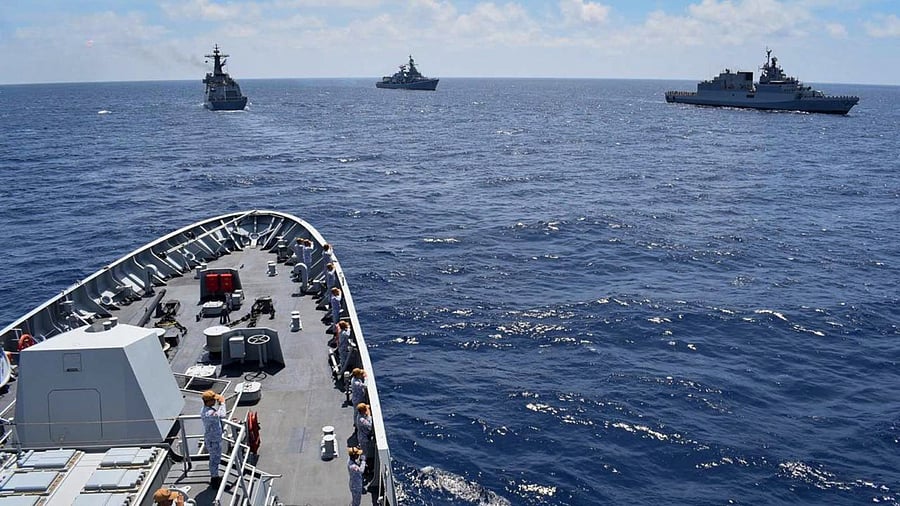
In this image released by Indian Navy on Aug. 5, 2025, As part of the ongoing Operational Deployment to South East Asia, Indian Naval Ships of the Eastern Fleet concluded their port call at Manila, Philippines.
Credit: PTI Photo
The year marks the 75th anniversary of the establishment of diplomatic relations between India and the Philippines. The Philippines' President Ferdinand R Marcos Jr is on a five-day State visit to India, and on August 5, both countries agreed to elevate the bilateral ties to a strategic partnership. A comprehensive action plan is in the works, and to further strengthen trade ties, the India-Asean free trade review will be completed as soon as possible. In addition, to boost tourism, both sides have decided to extend visa-free entry and start direct flights between New Delhi and Manila by the end of 2025.
While New Delhi-Manila ties are strengthening, it is important to see how Beijing — with which both countries have unsettled differences, especially territorial — reacts to it.
The navies of both countries also conducted their first joint exercise in the South China Sea to overlap with the visit. When asked about the Chinese reactions without directly referring to Beijing, Philippine military chief Romeo Brawner said, “We did not experience any untoward incidents, but there are still those shadowing us…. [this] sends a powerful signal of solidarity, strength in partnership and the energy of cooperation between two vibrant democracies in the Indo-Pacific”.
While boosting joint exercises and military-to-military contacts, Manila has also shown a keen interest in buying defence equipment from New Delhi, especially the BrahMos. In 2022, Manila purchased BrahMos worth $375 million. The first batch of missiles was supplied in April 2024, and the second batch in April 2025. The BrahMos is a crucial part of Manila’s military modernisation.
The Chinese reactions to the exercise and the sale of BrahMos have been on expected lines. The Global Times reported that India is in a ‘transactional relationship with Manila’, that ‘external powers aren't genuine allies of the Philippines but use it as a pawn to check China or dump second-hand arms…these drills merely serve each country's self-interest and further complicate regional tensions’. Beijing has been arguing that Manila should refrain from creating ‘trouble and dangers’ in the South China Sea, further underscoring that it considers the whole of the South China Sea as its sphere of influence.
On the other hand, New Delhi has pushed the concepts of free and open access to navigation in international waters. The growing closeness between India and the Philippines also challenges Beijing’s idea of being the only major power in the region. A co-operation between New Delhi and Manila can challenge Beijing’s position in the region.
Manila has its reasons to push for more engagements with other non-regional players. In the last few years, there has been an increase in naval clashes between China and the Philippines. China has clearly shown that it does not respect international laws and organisations vis-à-vis its South China Sea disputes. The growing assertiveness under Xi Jinping further undermines Manila’s position. Thus, it is obvious that a smaller nation will look for co-operation with other like-minded nations to balance the scales as far as possible. Manila and Washington have shown their commitment to the 1951 Mutual Defence Treaty. While Japan has also played an important role and has even supplied Manila with two used naval ships, while also engaging in regular naval exercises and defence co-operation.
Manila is keen to strengthen its defence capabilities, and India is a likely partner in this. New Delhi is also looking for ways to expand its defence exports, and it has aligned well with Manila’s ambitions of modernising its army under a looming Chinese threat.
Manila’s closeness to Washington has been an irritant to Beijing, which has steadily reiterated that Manila should not act as Washington’s proxy in the region. That said, it is China that has consistently attempted to arm-twist the Philippines. Beijing has always been uncomfortable with Manila attempting to forge an independent foreign and diplomatic route, which does not align with its aspirations.
Beijing’s reaction to actions by its neighbours must be seen as an extended reaction to its ongoing trade war with Washington. China is known to weaponise its trade to arm-twist countries.
In the Global Times, Beijing asks a cautionary question: ‘Is [the Philippines] prepared to sacrifice its immediate economic interests and long-term political gains? And even if it does make such a sacrifice, will this really deliver the outcome the Philippines is hoping for?”.
(Gunjan Singh is Associate Professor, OP Jindal Global University)
Disclaimer: The views expressed above are the author's own. They do not necessarily reflect the views of DH.